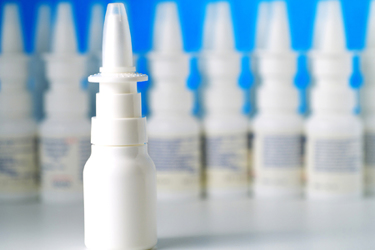Beyond Parenteral: Alternative Administration Of Biologics Shows Promise

By Matthew Pillar, Editor, Bioprocess Online

In virtually any market, an 8-to-10-year CAGR forecast between 5 and 10 percent is good. 20 percent is great. 30 percent is stellar.
Coherent Market Research pegs the oral biologics market to grow at a CAGR of more than 35 percent through 2028.
But the mouth isn’t the only alternative approach to biologic vaccine and therapeutic administration, and tablets and capsules aren’t the only formulations making waves. The nasal epithelium presents an increasingly promising site of administration of large molecules. That’s a partial drive of analyst expectations that the intranasal drug delivery market will hit $71.3 Billion by 2026 (per Global Industry Analysts Inc.).

To get an inside read on the bioprocessing technology advances driving the mucosal administration of biologics, we sat down with the leaders of two clinical-stage biopharma companies on the front lines, both advancing clinical programs on solid data.
Why It’s Time For Oral, Pulmonary, And Intranasal Biologics
For obvious reasons, the once-sleepy vaccine market has woken up in a big way. But with a vaccine hesitancy debate raging as some 44 percent of the adult U.S. population — and 51 percent of the global population — remain unvaccinated for COVID-19, vaccines represent one of the most promising areas for alternative biologics formulation and administration. Consider that:
- In a study of 1,500 U.S. adults, Quadrant Strategies found that 32 percent of those with no intentions to get the COVID-19 vaccine would likely get the vaccine if offered in pill form. The study found that 22 percent of U.S. adults are afraid of needles, and that figure rises to 27 percent among those who don’t plan to be vaccinated. Vaccine hesitancy takes many shapes, and parenteral administration — wariness of the jab — is chief among them.
- Vaccines offered in pill form would contribute significantly to their equitable distribution. Shelf-stable capsules or dry powders could contribute to significantly reduced packaging, shipping, storage, and administration costs. Per the Quadrant study, 81 percent of Americans support the development of a vaccine pill that will eliminate the need for freezers and simplify distribution, and 50 percent say making an appointment for vaccine administration was “very frustrating.”
It’s reasonable to hypothesize that these concerns apply to the parenteral administration of biologics in general. But while the business case for mucosal administration of biologics has been long-established, the enabling science and technology required to make it happen have been the sticking points. While one-off oral vaccines have played roles in the eradication of disease over the years (e.g., a polio vaccine serum administered on a sugar cube), there hasn’t been a mature and replicable “platform approach” to their manufacture. But a handful of specialized biopharma companies are working in earnest to change that.
Addressing Oral Vaccines’ Vexing Challenges
Sean Tucker, Ph.D. is founder and chief scientific officer at Vaxart, a clinical-stage developer of oral vaccine candidates for norovirus, influenza, RSV, HPV, and COVID-19. In fact, in October 2021, Vaxart became the first company to reach Phase II human clinical trials with an oral COVID-19 vaccine.
Dr. Tucker launched the company back in 2004, on an oral vaccine mission from the outset, and acknowledging head-on the challenges ahead. One such challenge stands above the rest as the first bar to clear for entry into the oral biologics arena: When you put a protein in the intestine, the body’s default response isn’t to turn on the immune system. It’s to digest the protein as food.
“Our challenge was to inform the immune system that the protein we’re introducing to the intestine is a foreign pathogen, and the immune system needs to pay attention,” explains Dr. Tucker. Vaxart solved that problem with a decoy strategy, triggering the immune response with a double-stranded RNA hairpin (the adjuvant) co-expressed with the protein of interest. Double-stranded RNA is not present in a healthy human intestine, but it is present in those infected with certain viral pathogens. “We developed the RNA hairpin as a signal to the immune system to turn on, go after the protein, and go after it very rigorously.”
With that biology proven out in the lab, Vaxart’s next challenge was to determine the optimal intestinal location to deliver the payload, a challenge that’s confounded researchers for more than a century due to seemingly impenetrable mucosal and epithelial barriers in the GI tract. Radio-labeled tracing technology enabled that study.
“We qualified people capable of swallowing a 000-gauge capsule [that’s longer than a quarter, for reference] filled with a radioactive fluid and our vaccine in liquid form. This allowed us to trace, direct, and visualize the release of the capsule’s contents,” says Tucker. “We compared the upper small intestine to the lower small intestine to determine the optimal point of release for eliciting immune responses to the vaccine. We then designed our tablets to open at that same location,” he says.
The vaccine itself is based on a non-replicating adenovirus produced in a fashion very similar to sterile injectable vaccines — to a point — and it’s at that point that Vaxart faced a manufacturing challenge ubiquitous among those developing oral biologics. “We had to figure out how to take a large biologic, dry it, and tablet it. There’s plenty of expertise out there for doing that with small molecules. The subset of people who understand how to tablet a large biologic was wafer thin,” says Dr. Tucker.
Vaxart found experts and set them to work on process development. “It took us a while to establish the conditions necessary to tablet and dry a large biologic while keeping it intact, but it’s become our differentiator,” says Dr. Tucker. “With the process established, we’ve found that tableting is actually faster, easier, and cheaper than moving through sterile fill/finish of vials and syringes,” he says. “That’s complicated and prone to contamination. Tablets hold the potential for a significant advantage on the downstream side of the process.”
Potential Therapeutic, Administration, and Accessibility Advantages
“The RNA technologies are really great from the standpoint of manufacturing speed,” says Dr. Tucker, “but you have to keep them very cold. That’s not easy to do. The United States had to build a lot of infrastructure to support the rollout of the COVID-19 vaccine, from cold storage and transport to qualifying professionals capable of putting shots in arms.”
Vaxart candidates, by contrast, have shown room temperature stability beyond two years and 35-to-45-degree Celsius stability for several weeks, demonstrating the potential of its supply chain advantage. But Dr. Tucker points to potential therapeutic advantages as well. “When you put a needle into someone’s arm, you get serum antibodies. That's good for some indications, but it's not for everything,” he says. Indeed, most pathogens don't invade humans by way of a mosquito bite or a flesh wound—they enter our weakest points of entry: the nose and the mouth. “One of the key advantages of a mucosal vaccine is that you’re inciting a mucosal response,” says Dr. Tucker. “The first line of defense is the respiratory tract for flu and coronavirus, and the mouth and intestines for norovirus.” There might also be a social advantage to putting up a defense at the pathogen’s point of entry. A Duke University-led study published in bioRxiv demonstrated that Vaxart's oral COVID-19 vaccine candidate reduces airborne transmission of SARS-CoV-2 infection in animal models, confirming previous findings suggesting mucosal vaccines could reduce transmission of airborne viruses such as COVID-19 and flu more than injectable vaccines. Dr. Tucker thinks that’s an important discovery, given that still fewer than half of the world population has receive the COVID vaccine.
“While there are orally-administered vaccines available for typhoid and polio, which are basically replicating attenuated pathogens, they're not really scalable platforms that could be used for multiple indications,” says Dr. Tucker. “With this platform, if we want to develop a new vaccine for RSV or some other virus, we can do it with just a little cutting and pasting of DNA.”
We’ve come a long way from drizzling biologic syrup on a sugar cube.
Developing Biologic Administration Optionality
Historically, the administration of biologic therapies and vaccines has almost always been a needles-and-blood proposition for patients and caregivers. Specialty pharmaceutical company TFF has been exploring myriad avenues to change that paradigm, all centered on its proprietary Thin Film Freezing technology. When successful, the therapeutic result of TFF’s effort has the potential to be inhaled, reconstituted into a sterile injectable, encapsulated, or tableted.
TFF is unique in that follows the 505(b)(2) regulatory pathway, intended for the reformulation of molecules that have been previously deemed safe and effective by the FDA. The intent of those reformulation efforts is to lower development costs and shorten development timelines, and the model has attracted plenty of interest. Company President and CEO Glenn Mattes tells us his company is currently engaged in development agreements with more than 45 biopharma and pharmaceutical companies, academic institutions, and government agencies. That’s in addition to TFF’s internal pipeline, which includes the clinical-stage dry powder formulations of small molecules Voriconazole and Tacrolimus and preclinical Niclosamide.
That TFF has garnered so much attention since its founding in 2018 offers street-level proof of the aggressive forecast for alternatively administered biologics. Its biologic portfolio includes undisclosed vaccine, mRNA and sRNA, monoclonal antibody (mAb), peptide, and phage compounds in development.
“The whole approach is really geared towards optimizing the delivery of the therapy in a dose that's suitable to optimize the efficacy versus the adverse events potential of the individual compound,” says Mattes. “Ideally, the target product profiles that we're looking to create are ones where you can achieve optimal blood levels of the therapeutic or vaccine, while administering the smallest dose possible to get there. We're hoping to achieve equal-to-better efficacy than parenteral standards, a better adverse events profile, and fewer drug-to-drug interactions,” he says.
Turning Complex Large Molecules Into Biologic Dust
Just as Dr. Tucker at Vaxart faced biologic and technological hurdles in the company’s oral biologics development effort, Mattes says TFF has embraced its own dry powder biologic formulation challenges.
“Turning biologics into powders is quite unique, and the larger and more complex the molecule, the more challenging the task,” says Mattes. “That’s where Thin Film Freezing technology really differentiates itself from other technologies that result in powders, such as spray drying and freeze drying.”
Those technologies, he says, are straightforward and require little in the way of capital investment, but they present molecule-specific application limitations. They’re perfectly suitable for dry formulation of commercial volumes of small molecules, but not necessarily up to the task of addressing a complex and wide range of large molecules.
TFF’s approach is proprietary, yet replicable. The process involves dissolving the drug in a solvent of agents designed to promote dispersion and avoid clumping, and excipients to promote adhesion to the target site. The drug solution is then applied to a cryogenic substrate, a custom-fabricated liquid nitrogen-cooled stainless-steel drum. When the drug solution contacts the cryogenic surface, it vitrifies, or flash freezes, resulting in an amorphous “drug ice.” The solvent system is then removed by lyophilization, resulting in highly porous, large surface area, low-density Brittle Matrix Particles. The process uses industry standard solvents, approved excipients, a custom-made TFF drum and conventional process equipment.
Demand Drives Process Development
The interest in TFF’s technology has driven engagements with the majority of the top 20 pharma companies, some on multiple projects. While some of those engagements are understandably undiscussable ‘skunkworks’ operations in partnership with commercial-stage entities, Mattes explains that TFF’s partnered programs are progressing steadily toward clinical development. “It’s a process. It takes time to formulate, optimize, get the in vitro work done, do animal and do stability testing,” says Mattes. “But we have several projects moving downstream very nicely.”
Mattes is particularly enthusiastic about the progress the company has made in the past 12 months. “We’ve published the application of the technology to mRNA, mAbs, phages, and peptides. We’ve expanded our patent count to more than 97 that are approved or filed for a method of use process or composition of matter. And we’ve established important academic partnerships that we didn’t have a year ago.” Those partnerships include one with the University of Georgia’s Dr. Ted Ross on development of Thin Film Freezing versions of a new pulmonary administration universal flu vaccine, and another with Dr. Kartik Chandran, Ph.D., professor at the Albert Einstein College of Medicine, to develop dry powder formulations of the rVSV vaccine against COVID-19.
TFF is also engaged via a Cooperative Research and Development Agreement (CRADA) with Dr. John Dye of the United States Army Medical Research Institute of Infectious Disease (USAMRIID), with the goal to formulate both a monoclonal antibody against Alphaviruses (e.g., Venezuelan, Western, and Eastern equine encephalitis viruses) and a vesicular stomatitis virus vaccine against Filoviruses (e.g., Ebola, Marburg), to be leveraged as countermeasures to biologic threats to our fighting forces.
It’s also added the University of Pennsylvania’s Dr. Drew Weissman, M.D., Ph.D. to its scientific advisory board. Dr. Weissman is credited with the development work that enabled the BioNTech / Pfizer COVID-19 vaccine.
All this attention lends credibility to the dry powder biologic formulation concept, and it’s spurred further development. “It’s one of those ‘if you build it, they will come’ situations. We’ve built the platform, you just need a space to install the equipment,” says Mattes.
In fact, global CDMO powerhouse Catalent has put space, and skin, in the game as well. It’s facilitating TFF’s current dry powder biologic GMP manufacturing efforts, beginning with the Augmenta Bioworks candidate AUG-3387, an anti-COVID antibody that TFF is working to formulate as a pulmonary-administered COVID-19 therapy. Preclinical data published in October 2021 in bioRxiv showed that delivery of a dry powder formulation of AUG-3887 in hamsters reduced viral load 24 hours after infection with SARS-CoV-2, demonstrating initial proof-of-concept of TFF’s inhaled approach and suggesting this antibody may perform better than other mAb treatments approved under Emergency Use Authorization. TFF and Augmenta plan to move the candidate into clinical studies in mid-2022.
Future State Of Alternative Biologic Therapy Administration
TFF and Vaxart are two companies with concrete and fast-moving plans to democratize biologics. Capsules and dry powder formulations are key to those plans. The technologies they’re developing are establishing a path toward minimally invasive administration of powerful vaccines and therapies, at the site of infection, with fewer adverse effects, and at a cheaper cost of storage and distribution. But they aren’t the only players in the game. Fueled by high patient demand and tech development there’s a growing cottage industry of biopharma innovators in the space:
- A Celltrion/Intract partnership is on pace for a Phase II study of orally delivered infliximab for IBD in 2022.
- Progenity plans to enter the clinic in 2022 with high-concentration formulations of adalimumab and liraglutide administered orally via the company’s oral biopharmaceutical delivery system.
- Rani Therapeutics has tested a “microneedle” capsule designed to permeate a specific area of the GI tract prior to payload release in a Phase I study of the biologic Ocreotide for acromegaly.
- Entera Bio is entering a Phase II study of an oral teriparatide formulation for osteoporosis, leveraging a capsule designed to chemically compromise the intestinal wall to enable large molecule absorption.
- BlueWillow Biologics’ NanoVax platform is playing host to preclinical intranasally-delivered vaccines for anthrax, COVID-19, flu, herpes, peanut allergies, and RSV.
- FluGen’s intranasal M2SR influenza vaccine candidate demonstrated favorable data in a human challenge study conducted this year.
That’s just a sampling of the current alternative biologic formulation and administration activity we’re seeing as we round the corner to 2022. We anticipate considerable progress — and a growing playing field — as robust capital markets and patient demand feed the development engine.
(Editor’s Note: This article was originally published in the annual Outlook Issue of Life Science Leader magazine, December 1st 2021)
